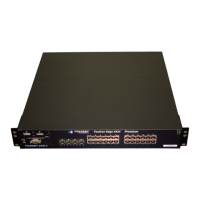Traffic Policies
December 2005 © Foundry Networks, Inc. 15 3
Maximum Number of Traffic Policies Supported on a Device
The maximum number of supported active traffic policies is a system-wide parameter and depends on the device
you are configuring, as follows:
• By default, up to 1024 active traffic policies are supported on Layer 2 switches. This value is fixed on Layer 2
switches and cannot be modified.
• The number of active traffic policies supported on Layer 3 switches varies depending on the configuration and
the available system memory. The default value and also the maximum number of traffic policies supported
on Layer 3 switches is 50.
Setting the Maximum Number of Traffic Policies Supported on a Layer 3 Device
If desired you can adjust the maximum number of active traffic policies that a Layer 3 device will support. To do
so, enter commands such as the following at the Global CONFIG level of the CLI:
FESX424 Switch(config)# system-max hw-traffic-conditioner 25
FESX424 Switch(config)# write memory
FESX424 Switch(config)# reload
NOTE: You must save the configuration and reload the software to place the change into effect.
Syntax: [no] system-max hw-traffic-conditioner <num>
<num> is a value from 0 to n, where 0 disables hardware resources for traffic policies, and n is a number up to
1024. The maximum number you can configure depends on the configuration and available memory on your
device. If the configuration you enter causes the device to exceed the available memory, the device will reject the
configuration and display a warning message on the console.
NOTE: Foundry does not recommend setting the system-max for traffic policies to 0 (zero), since this renders
traffic policies ineffective.
ACL-Based Rate Limiting via Traffic Policies
Software release 02.3.03 provides support for IP ACL-based rate limiting of inbound traffic. ACL-based rate
limiting provides the facility to limit the rate for IP traffic that matches the permit conditions in extended IP ACLs.
This feature is available in the Layer 2 and Layer 3 code.
To configure ACL-based rate limiting on an X-Series device, you create individual traffic policies, then reference
the traffic policies in one or more ACL entries (also called clauses or statements). The traffic policies become
effective on ports to which the ACLs are bound. See “About Traffic Policies” on page 15-1.
When you configure a traffic policy for rate limiting, the device automatically enables rate limit counting, similar to
the two-rate three-color marker (trTCM) mechanism described in RFC 2698 for adaptive rate limiting, and the
single-rate three-color marker (srTCM) mechanism described in RFC 2697 for fixed rate limiting. This feature
counts the number of bytes and trTCM or srTCM conformance level per packet to which rate limiting traffic policies
are applied. See “ACL and Rate Limit Counting” on page 15-7.
You can configure ACL-based rate limiting on the following interface types:
• physical Ethernet interfaces
• virtual interfaces
• trunk ports
• specific VLAN members on a port (New in 02.3.03 – see “Applying an ACL to Specific VLAN Members on a
Port (Layer 2 Devices Only)” on page 12-21
• a subset of ports on a virtual interface (New in 02.3.03 – see “Applying an ACL to a Subset of Ports on a
Virtual Interface (Layer 3 Devices Only)” on page 12-21.)

